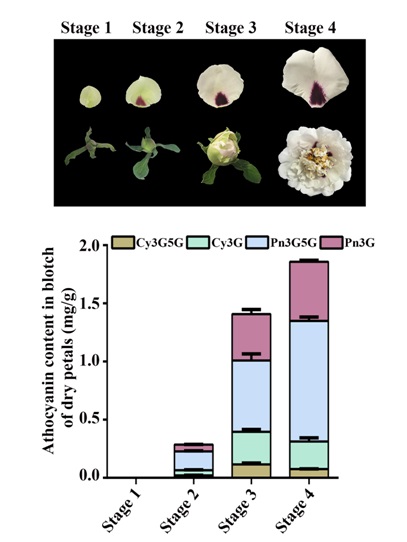Flower color patterns play critical roles in plant–pollinator interactions and represent one of the most common adaptations during angiosperm evolution.
Petal blotch is a particular character among various species including tree peony (Paeonia suffruticosa). Besides, as an important ornamental character of tree peony, petal blotch contributes to the gradation and variety of flower color.
At present, the molecular mechanisms underlying flower color pattern formation are less understood in non-model organisms.
Since flavonoid is main ingredient of flower color, the transcription activity of key enzyme coding genes (including CHS/CHI/F3H/F3’H/F3’5’H/DFR/ANS/UFGT/FOMT) involving in flavonoid biosynthesis pathway are regulated by transcription factors.
Researchers from the Institute of Botany, Chinese Academy of Sciences (IBCAS) identified an R2R3-MYB transcription factor, PsMYB12, tightly associated with petal blotch development.
The study shows that both PsCHS and PsMYB12 are specifically transcribed in blotched areas, so that it may be resulting in the difference between petal blotch and non-blotch regions.
The classification of PsMYB12 in a new R2R3-MYB subgroup with VvMYBPA1 suggests functional specialization in flavonoid biosynthesis.
The results of mutual analysis show that a protein complex of PsMYB12, interacting with a WD repeat-containing protein (PsWD40) and a bHLH transcription factor (PsbHLH), binds to the promoter of PsCHS, as a result activates PsCHS transcription in petal blotch region.
This study identified and characterized the MYB–bHLH–WD40 regulatory complex in tree peony, and setting the stage for identifying their role in floral pigment patterning in Paeoniaceae. The results will not only benefit molecular breeding of tree peony cultivars with novel color patterns, but also enrich the knowledge in the molecular mechanism of pigment patterning beyond model plants.
The study has been published in Plant & Cell Physiology entitled “A novel R2R3-MYB transcription factor contributes to petal blotch formation by regulating organ-specific expression of PsCHS in tree peony (Paeonia suffruticosa)”.
This work was supported by the Natural Science Foundation of China.

Petal blotch development and anthocyanin accumulation in tree peony.
https://academic.oup.com/pcp/advance-article/doi/10.1093/pcp/pcy232/5215161?searchresult=1
CONTAC INFO:
Institute of Botany, Chinese Academy of Sciences,
20 Nanxincun, Xiangshan, Beijing 100093, China
E-mail: Int_office@ibcas.ac.cn
Flower color patterns play critical roles in plant–pollinator interactions and represent one of the most common adaptations during angiosperm evolution.
Petal blotch is a particular character among various species including tree peony (Paeonia suffruticosa). Besides, as an important ornamental character of tree peony, petal blotch contributes to the gradation and variety of flower color.
At present, the molecular mechanisms underlying flower color pattern formation are less understood in non-model organisms.
Since flavonoid is main ingredient of flower color, the transcription activity of key enzyme coding genes (including CHS/CHI/F3H/F3’H/F3’5’H/DFR/ANS/UFGT/FOMT) involving in flavonoid biosynthesis pathway are regulated by transcription factors.
Researchers from the Institute of Botany, Chinese Academy of Sciences (IBCAS) identified an R2R3-MYB transcription factor, PsMYB12, tightly associated with petal blotch development.
The study shows that both PsCHS and PsMYB12 are specifically transcribed in blotched areas, so that it may be resulting in the difference between petal blotch and non-blotch regions.
The classification of PsMYB12 in a new R2R3-MYB subgroup with VvMYBPA1 suggests functional specialization in flavonoid biosynthesis.
The results of mutual analysis show that a protein complex of PsMYB12, interacting with a WD repeat-containing protein (PsWD40) and a bHLH transcription factor (PsbHLH), binds to the promoter of PsCHS, as a result activates PsCHS transcription in petal blotch region.
This study identified and characterized the MYB–bHLH–WD40 regulatory complex in tree peony, and setting the stage for identifying their role in floral pigment patterning in Paeoniaceae. The results will not only benefit molecular breeding of tree peony cultivars with novel color patterns, but also enrich the knowledge in the molecular mechanism of pigment patterning beyond model plants.
The study has been published in Plant & Cell Physiology entitled “A novel R2R3-MYB transcription factor contributes to petal blotch formation by regulating organ-specific expression of PsCHS in tree peony (Paeonia suffruticosa)”.
This work was supported by the Natural Science Foundation of China.

Petal blotch development and anthocyanin accumulation in tree peony.
https://academic.oup.com/pcp/advance-article/doi/10.1093/pcp/pcy232/5215161?searchresult=1
CONTAC INFO:
Institute of Botany, Chinese Academy of Sciences,
20 Nanxincun, Xiangshan, Beijing 100093, China
E-mail: Int_office@ibcas.ac.cn
